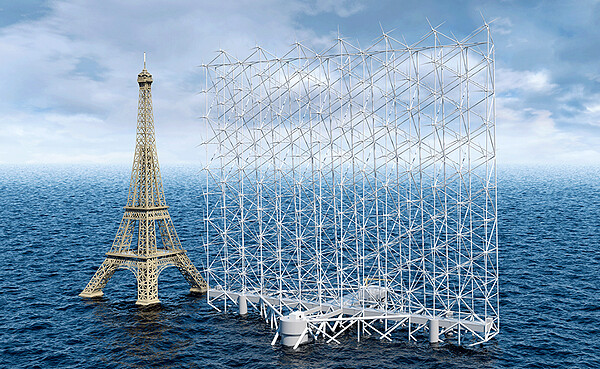美國拜登政府9月15日宣布啟動「浮式離岸風電旗艦計畫」(Floating Offshore Wind Shot),將透過一系列行動方案建置離岸風電浮動平台,讓美國成為離岸風電的領導者。
預計這項旗艦計畫可為數百萬戶家庭和企業提供風電,因應氣候危機的同時,帶動美國本土產業和海運業商機。
傳統的離岸風機須固定在海床,僅適用在水深較淺的海域,如美國東岸和墨西哥灣。在深海區,風機無法固定海床上,須將風機固定在浮動平台,再以纜線拉住平台。美國離岸風電近2/3的潛能都位在深海區,西岸及緬因灣一帶深具潛力。
藉旗艦計畫之力降低技術成本
「浮式離岸風電旗艦計畫」是美國能源部去年所啟動的「能源地球計畫」(Energy Earthshot)的一環,目標是突破工程、製造和創新上的瓶頸,加速浮式離岸風電進程、降低風電成本,希望在2035年前降低70%以上,達到每MWh 45美元。
拜登政府的離岸風電目標是2030年前設置30GW,這項目標將以固定式離岸風機為主。浮式離岸風電的目標則是在2035年部署15GW,而距離這項目標僅剩13年。
為達成這項目標,拜登政府發起一系列行動,例如浮式離岸風機平台技術競賽;由跨黨基礎建設法(Bipartisan Infrastructure Law)所資助的浮式風電專案模組與港口分析計畫,以及數項研究、開發和示範獎勵的資助計畫。從新增目標、計畫、投資,拜登政府傾全政府之力(all-of-government approach)推動離岸風電,盼發展風電的同時,也能兼顧環境正義、生物多樣性與海洋空間共用(co-use)。

美國剛通過的《降低通膨法案》(Inflation Reduction Act)將為潔淨能源提供稅額抵減。藉由扶植本土製造的風機葉片、固定式水下基礎、風機浮動平台、安裝船和運維船等,加速產業與供應鏈的進展。
白宮將浮式離岸風電當作引領美國經濟前進的契機。白宮表示:「全球固定式離岸風電的裝置容量已超過50GW,浮式離岸風電卻僅有0.1GW。透過這些行動,美國將成為浮式離岸風電科技的領頭羊。」
今年8月,美國能源部風電技術辦公室(Wind Energy Technologies Office)與國家再生能源實驗室(National Renewable Energy Lab)共同完成《離岸風電市場報告:2022年版》(Offshore Wind Market Report: 2022 Edition),詳細介紹全球和美國離岸風電業產業。藉由最新數據和趨勢,讓大眾能進一步了解風電的技術、瓶頸與機會。
The Biden Administration is launching a fleet of coordinated actions to develop floating offshore wind platforms, an emerging clean energy technology that will help the United States lead on offshore wind. Called the “Floating Offshore Wind Shot,” the new program will capture this potential to power millions of homes and businesses, grow new manufacturing and maritime industries, and tackle the climate crisis.
Conventional offshore wind turbines can be secured directly to the sea floor in shallow waters near the East Coast and the Gulf of Mexico. But areas where the ocean is too deep to anchor turbines with cables require floating platforms for the turbines. These deep water areas hold two-thirds of America’s offshore wind energy potential, especially along the West Coast and in the Gulf of Maine.
Floating Offshore Wind Shot Aims to Lower Tech Costs
Through the Department of Energy’s existing Energy Earthshot program, started last year, the administration will create the new Floating Offshore Wind Shot initiative to accelerate breakthroughs across engineering, manufacturing, and other innovation areas.
The Floating Offshore Wind Shot will aim to reduce the costs of floating technologies by more than 70 percent by 2035, to $45 per megawatt-hour.
Building on the President’s existing goal of deploying 30 gigawatts, GW, of offshore wind by 2030, which will be largely met using fixed-bottom technology, the administration has set a new goal – to reach 15 GW of floating wind capacity by 2035. The government will advance lease areas in deep waters to deploy 15 GW of floating offshore wind capacity by that date – 13 years from now.
To support these goals, this week the administration launched a new prize competition for floating offshore wind platform technologies; initiatives funded by the Bipartisan Infrastructure Law to develop modeling tools for project design and to analyze port needs; and other funding for research, development, and demonstration efforts.
These new goals, initiatives, and investments focus on floating technologies and build on the administration’s all-of-government approach to developing offshore wind while advancing environmental justice, protecting biodiversity, and promoting ocean co-use.
Through the Inflation Reduction Act, President Biden secured clean energy tax credits that will further accelerate this new American industry and a thriving domestic supply chain, with support for Made in America wind turbine blades, fixed-bottom and floating platforms, installation and service vessels.
The White House sees floating offshore wind as a major opportunity for the United States economy, saying, “Globally, only 0.1 GW of floating offshore wind has been deployed to date, compared with over 50 GW of fixed-bottom offshore wind. Today’s actions will position the U.S. to lead the world on floating offshore wind technology.”
In August, the Department of Energy Wind Energy Technologies Office released the “Offshore Wind Market Report: 2022 Edition,” co-authored by several researchers at the National Renewable Energy Lab. The report details information on the global and domestic offshore wind industry to provide current data and trends to help readers navigate technical and market barriers and opportunities.
※ 全文及圖片詳見:ENS








